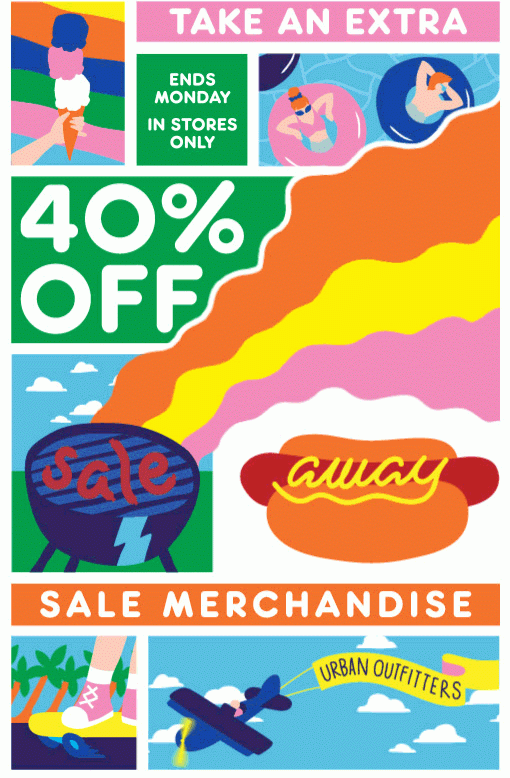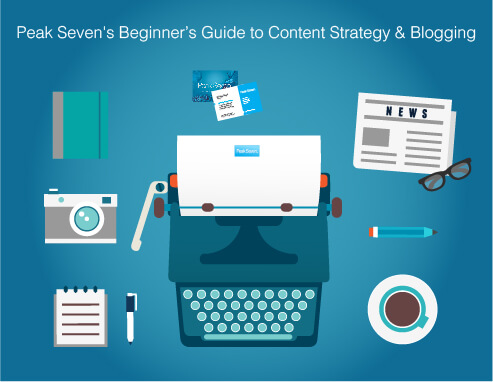Content Marketing
August 27, 2014
When I was in 4th grade, there was nothing I wanted more than a Geocities webpage to showcase my obsession with Sailor Moon (a popular Japanese anime show). Geocities pages were the perfect beginner webpages: they started free, and almost anybody could design a page to their liking. “Cool” webpages had tons and tons of images and not a lot of text. But webpages that really were worth sharing were the webpages that had your name in sparkling pink letters (thanks FlamingText.com), an “under construction” sign that flipped vertically, or a dancing banana. These moving or animated images are called “GIFs,” an acronym for “graphic interchange format.” After being MIA following the demise of MySpace and the rising popularity of limited design social media sites like Facebook, GIFs are having a renaissance. But like most things these days we have to wonder: are GIFs back for good, or is this just another Millennial fad?
GIFs made their official debut in 1987, hence the painfully outdated name of “graphic interchange format,” Almost immediately the GIF met controversy in a copyright war that lasted until 1994. The disagreement ended in the winning company licensing the GIF format to other companies for a fee. Most people didn’t want to pay, and ditched GIFs for the PNG format by 1996 – a free, non-patented single-image format. By the early 2000’s, time had passed: we survived Y2K, Britney Spears was America’s Sweetheart, and the GIF patent had expired. ربح المال من لعب الالعاب Enter Geocities and inexperienced Internet users.
Before MySpace and Facebook, there was Geocities, and what better way to express your limited HTML knowledge and trendiness than with a bunch of animated images? GIFs are compressed image files, meaning they could more easily load for people with modem connections and outdated web browsers. The ease of loading GIFs made GIFs accessible for people of all Internet speeds and bandwidths. Remember, this is the time before we had YouTube, Vimeo, Netflix, and Hulu: accessing video files used to take hours! How people ever survived is a mystery to me. Somewhere around 2001, a flash music video for the song “Peanut Butter Jelly Time” featuring a pixelated, dancing banana took over the World Wide Web. The dancing banana went on to be one of the most popular GIFs of that time. After the Geocities craze came the next bigger and better Internet trend: MySpace. MySpace was hot for about four years and truly kicked off our dependence on social media. Other than constantly worrying about who should be in my Top 8, I know I was one of the millions of teenagers who spent far too many hours littering their MySpace profile with as many GIFs as humanly possible. قوانين البوكر Why did we love GIFs so much? They were new, shiny, fun, and added a little bit of quirk to an otherwise stereotypical MySpace page. Once Facebook eclipsed MySpace in users, GIFs died out because Facebook only offered, and still only offers, limited customization aspects on profiles. However, like most trends including Jelly sandals from the 90’s and unfortunately overalls, every trend gets a second-go, and now is the time for GIFs.
Today, thanks mainly to Tumblr, the home of many GIF-centric pages, we have GIFs for every situation, every reaction and every feeling featuring clips from TV shows, music videos, movies, YouTube videos, you name it. Furthermore, companies like Victoria’s Secret PINK, J.Crew, and Steve Madden are cashing in on the GIF trend by using their merchandise to create GIF images on their marketing emails. لعبة قمار For example, Victoria’s Secret PINK recently sent out an e-mail promoting their collegiate collection, featuring an image model with the pullover sweatshirt she was wearing changing every few seconds to showcase different colleges and universities. Steve Madden often features GIF images in their emails with rotating images of their latest and greatest shoes. Even K-Mart got on the GIF-train during the 2013 Holiday Season with a “GIFing Out” campaign. This campaign featured commercials of family members doing strange repeated movements after scoring great deals at K-Mart, to which the onlookers would remark that their family member was “GIFing out.”
GIFs have evolved greatly past pixelated images. In addition to having a GIF for any mood, we now have “cinemagraphs,” which feature still images with only a minor repeated detail moving. But what does this mean for the future of GIFs; are they here to stay, or are they another fleeting millennial fad? Kerry Trainor, CEO of Vimeo, stated, “We really feel like the GIF format overall really represents an interesting connecting tissue between what people typically think of as video and what people typically think of as still images… This is a new area of video creativity that we think bridges the gap between video and still photography.” With the attention span of users shorter than ever and the number of hours in a day ever dwindling, it is important for marketers to provide users with content that can be accessed quickly and easily. Sure, YouTube and Vimeo videos are great, but users’ time is limited, and watching a minutes-long video just takes up too much of their precious time. Not to mention buffer time! Enter the GIF – typically a few seconds long – short enough but to the point. Furthermore, GIFs can be instantly shared through social media, bypassing the inconvenience of having to click the play or pause button like on a YouTube video. Are GIFs the future of video? Will there one day be a social media site dedicated only to GIFs? As the popularity of GIFs continues to increase, I personally believe these are not such farfetched ideas.
So how can you jump on the GIF-train for your business? First, you can share GIFs across your social media accounts: be it Facebook, Google+, or even your blog. GIFs don’t always work on all social media platforms (Instagram and Pinterest for example) but they can help spice up your posts on social media platforms where they do. Whether you are sharing original, curated or repurposed content, GIFs can help tell your story with a little quirk and flare. Another way you can use GIFs for business is by creating GIFs that are centric to your work. In other words – don’t just use or make a GIF just to say you did. If you are using GIFs just to fit in or look cool, trust me, it’ll be painfully obvious. But when a GIF syncs with your brand or campaign, people will know who is responsible for that fun piece of content (you!). Email campaigns are another great outlet to create your original GIFs to market your latest and greatest products. As previously mentioned, Victoria’s Secret PINK has mastered the art of GIF marketing, as has Urban Outfitters. Lastly, if you are a website or blog that frequently posts a lot of tips or how-to’s, GIFs can be used as an educational resource. Showing your readers how to follow your tips step-by-step in a short, repetitive clip will help keep readers from second-guessing your directions, or leaving your page to turn to YouTube for help.
When words can’t say what you’re feeling or thinking, a GIF can. GIFs are like Hallmark cards for Millennials, except free and less compassionate. As consumers’ attention dwindles and patience is fleeting, I believe marketers will eventually have to be even more creative and find a quicker way to reach their consumers, and GIFs are the perfect medium. With GIFs, your creativity is limitless – the only real boundary is your mind, and maybe some copyright laws (watch out for those when using content lifted from movies, TV shows, and anything you don’t). Below are some of my favorite GIFs, and of course, I included the dancing banana. Long live Peanut Butter Jelly Time!
Source: http://mashable.com/2012/10/19/animated-gif-history
Source: http://www.business2community.com/content-marketing/7-best-practices-using-gifs-cinemagraphs-business-0939520#!bLjeQm
Source: http://www.businessinsider.com/most-popular-gifs-of-2013-2013-12
Source: http://victorious.wikia.com/wiki/File:Cupcake_dog_gif.gif
Source: http://img4.wikia.nocookie.net/__cb20070819174055/uncyclopedia/images/b/be/200px-Dancing_Banana.gif
Source: http://vspink.com
Source: http://www.urbanoutfitters.com
August 20, 2014
It has been approximately nine years since Facebook consumed my life, and I’m not afraid to admit it. When Facebook first started to catch on, I was a sophomore in high school, and being the rebel that I was, I refused to get one initially. Keep in mind I initially also refused to try Chipotle because I “didn’t like Mexican food,” (but really I was lying to myself, I was just trying to be defiant). Neither of those delusions lasted very long, and soon I was a Chipotle and Facebook addicted teenager; a textbook Millennial.
When Facebook introduced “Pages” and made a push for them instead of user-created groups, it was a game changer. Gone were the days I spent mindlessly browsing for Facebook groups that I felt encompassed my interests and made my profile look cool. Now, connecting with people and companies was just a quick search and “Like” away! And, even better, you could easily see which of your friends shared your Likes as well. With stories from Pages now showing up on my newsfeed, I could easily see what was going on with all my interests, which made it infinitely easier for me to stay connected to things I cared about.
Why am I telling this story from my perspective? العاب رب وس حقيقية Because I am a consumer, and I now stay connected to all my favorite brands through Facebook. I even use Facebook to find coupons or learn about sales only valid for Facebook friends. To this day, I judge a brand’s legitimacy by its Facebook page. If you don’t have an updated and flourishing Facebook page, I question your legitimacy. If you aren’t keeping up with the Kardashians (sorry Jones family you’re out), you will surely be forgotten. Here are the top 6 reasons I believe everyone should have (at least) a Facebook Page for their business:
1). There are over a billion people on Facebook.
Each month 1.5 billion people use Facebook, trailed by Google+ at 359 million, then Twitter at 215 million, and then Instagram at 150 million. Pretty much this statement says that for a business, the world is your oyster via Facebook. Facebook allows you to connect with not millions but BILLIONS of customers around the world that you may never have otherwise reached with traditional marketing efforts.
2). 30 million businesses have Facebook pages.
But only 19 million have optimized for mobile (or are mobile friendly). If you have not optimized your page for Facebook mobile, then you are making your resources inaccessible to potential consumers who are on the go, have their cell phones glued to their hands, or are not confined to a desktop device, which nowadays seems like most people. If your business is brought up at a Starbucks between 2 Strawberries and Cream Frappuccinos and the two Millennials talking about your Facebook can’t access it because it isn’t mobile friendly, chances are they will have forgotten about you before even getting home; a missed business opportunity for you.
3). 25% of the Facebook-using population exclusively uses Facebook Mobile.
Following up to my previous point, 654 million people use Facebook on a mobile device daily, and 399 million users exclusively use Facebook mobile each month. Your Facebook page should be an extension of your resources, and not optimizing Facebook for mobile devices puts you at a great disadvantage by limiting your reach. Once again I reference the saying, “If a tree falls in the forest and nobody’s there to hear it, does it make a sound?” Similarly, if a consumer goes to your establishment but can’t check in on Facebook mobile, were they ever there? Millennial logic says no: if we can’t show off on a mobile Facebook check-in that we’ve been to the coolest new club or restaurant in town, it’s like we were never even there, and you miss that exposure to that users’ Facebook friends (which, by the way, was free).
4). 47% of Americans say that Facebook is their #1 influencer of purchases. لعبة الكازينو
Being able to interact with content, read customer feedback on pages and see the company remedy unsatisfied customers all attribute to a purchaser’s final decision. A few months ago, I purchased a dehydrated vegan soup (I was a huge fan of this brand until this incident), which, upon opening it, prompted live moths to fly out of the container. Furious, stunned, and extremely nauseated, I contacted the company via Facebook and complained about their disturbing lack of quality. Notice how my initial reaction was to head to their Facebook and not their company website. They are a small company, and it took them days to respond. In my post, I stated I did not want any replacements of their products; who would after that incident? What did they do, after taking days to respond? Offered me a replacement. Not only did they not listen to me, they did not remedy the situation, and that was present for their other 800+ fans on Facebook to see. Other people jumped in on the post, disappointed with the company. To this day, they have done nothing to remedy my situation, and I will never purchase their products again.
5). 42% of Marketers said that Facebook is critical to their business.
Although millions of businesses crowd Facebook with their pages, it is something no business can afford to sit out on. If you sit out joining Facebook like stubborn ol’ me tried to refuse to like Chipotle, you are ultimately giving your competition the upper hand in reaching the same consumers that you so desperately want. Furthermore, chances are you are already operating in an oversaturated industry. Why do we need another brand of jeans? Or another pizza place? Or another dry cleaners? If you have something special to offer that sets you apart from the millions of other businesses in your industry, your Facebook page is a great place to show it.
6). It’s a free tool for your marketing toolbox.
Yep, for the most part maintaining a Facebook Business Page, posting content, generating a following for your great content, interacting with new and potential customers, and posting about your products and services are all free. Facebook is an ideal platform to help you promote all the marketing material you’re creating and writing across social media platforms, in hopes that it’s intriguing enough for people to share it with their friends (all free exposure for you!) Paid advertising obviously costs money as does sponsor advertising, and paying for likes is something you should NEVER do. But that doesn’t mean you can’t be successful sticking to just the basics of Facebook for Business. If you have a great product to sell and have interesting content to share and a knack for interacting with even the toughest of consumers, there’s little chance you won’t be successful.
Of course, while social media like Facebook offers a great platform to engage with your audience, having eye-catching visuals is just as important to capture their attention. This is where a strong graphic design agency comes in. If you really want to elevate your business marketing and make your brand stand out, professional design can make all the difference.
Whether it’s creating logos, infographics, or social media graphics, Graphically can help take your brand to the next level. A well-designed visual not only grabs attention but also communicates your brand’s message clearly and effectively, helping you stay ahead in today’s competitive market. With the right blend of creativity and strategy, even the simplest content can become compelling enough for customers to engage and share, amplifying your reach without costing you a dime.
While I admit that Facebook has its flaws, having a Facebook presence is an undeniable marketing advantage for your business. Don’t try and be that hipster business that is “too cool” for Facebook, because you aren’t. بلاك جاك Social media is there to connect you to your customers and open doors to new customers: use it to your advantage. There’s a whole world of untapped business opportunities out there, so go get em Tiger. If you aren’t sure where to begin with content, we’ve got you covered.
Just like social media, a well-designed business card is a powerful tool that should not be underestimated. It’s often the first impression someone will have of your business, so why not make it count? A sleek, high-quality business card tells your potential clients that you’re serious about your brand and the services you offer. Think of it as a mini-billboard that fits right into someone’s wallet.
And if you really want to stand out from the crowd, consider Metal Kards. These premium cards don’t just sit in a pile—they make an impact, giving your business that extra edge and professionalism that people remember. In today’s competitive landscape, it’s all about making your brand memorable. Sure, digital marketing is great, but tangible items like business cards give people something to hold on to, something that lasts beyond the scroll.
Imagine handing out a metal business card at a networking event. The weight, the feel—it’s a conversation starter on its own. It’s not just about giving your contact info, it’s about making a statement that says, “Hey, I’m here, I’m serious, and I mean business.” So, whether you’re killing it on social media or making waves in face-to-face meetings, don’t overlook the simple yet effective power of a killer business card.
July 30, 2014
I have always been one to follow a schedule: get up, workout, eat, go to work, come home, eat some more, sleep, and repeat through Friday. When I fall off this schedule by either by skipping a workout or even a meal, I become stressed, which in turn affects my productivity and mood.
Blogging and content strategy go hand in hand, and require the author to follow a schedule and have a strategy. If you go in without a plan, you are setting yourself up to fail: you can easily make excuses and procrastinate until you no longer see the need to write that blog entry from over a week ago. To learn more about blogging, content strategy, and staying on track, we read Contently.com’s e-Book called “Blogging and Content Strategy.”
Why People & Companies Fail at Blogging
According to Contently.com, there are three main reasons why companies fail at blogging and content marketing:
1. They don’t invest in quality content.
2. They don’t execute consistently.
3. They don’t promote or optimize their content.
More so than time and research, blogging is about knowing your content, knowing your audience, and having a desire to grow and share that content with the world. If you are a fashion blog whose target audience are Millennials, and you blog about mom jeans and Crocs being trendy, you not only do not know your audience, but probably don’t have much of one either. Furthermore, many fashion blogs die out because their writers fail to post consistently. How is your reader supposed to know when to check back for new updates? And even more importantly, if you don’t promote yourself and try to get your name out there, you can never grow or go beyond your current reach. Now is the perfect opportunity to look into creating a game plan and strategy to ensure you’re on the path to success.
Starting On Success: Goals
Before writing your first post, you should define goals for your blog. Ask yourself questions such as how many subscribers do I want to obtain ultimately? Who do I want to share my content and to represent me in the niche I blog for? What do I consider success, conversions or ROI? Having solid goals before even starting will help you begin your path to success.
Strategizing Your Goals
Having a strategy is crucial to your blog’s success: if you have a plan to follow, you cannot make excuses for getting lost on your way. For example, many people who swear by eating clean follow a routine called “meal prep” where they prepare all of their take-to-work-lunches on Sunday night. Having a pre-made lunch for every day of the week ensures they will stay on their diet because excuses for not having time to make lunch during the week will be obsolete. Here is where content calendars come into play: make a content calendar so you never have writer’s block and subsequently can’t make excuses for never feeling inspired. Many blogs use Monday as “Motivational Monday” and Friday as a day to post lighter more fun content.
Making Great Content Your Reality
Content is the main ingredient in your cookbook to success. After all, why else are people looking at your blog in the first place? They have a hunger to learn, and you are a chef that will teach them the recipe.
You can find inspiration almost anywhere. You can grab content from looking at news articles online, be it Google Alerts, Twitter, or even just CNN.com. You can offer your critique on current events, celebrity gossip, or try and decode a celebrity’s cryptic tweets and Instagram posts. Piggybacking off of hot topics ups your chances of your content being read.
Selecting a Headline
Never underestimate the power of a good headline. Headlines are the first item a reader sees ultimately what triggers their interest to read the article. Your headline should reflect the content in your blog post, but should also be attention-grabbing. Your sub-header should contain more information on your main points, but still maintains your reader’s interest in clicking on your post.
Luring Your Audience In
Another strategy to engage your readers is linking to related posts. If you put links to related posts on your blog at the bottom of your post, you can see an increased engagement among your readers, as they will stick around longer to check out your content. Contently.com also recommends utilizing the “Wikipedia Link Luring Wormhole” strategy, which involves putting links to previous related posts in each paragraph, engaging your reader to spend more time checking out your posts.
Influencing Your Audience
If you are a chef and your audience is your guests, you want them to leave feeling satisfied and happy. If your guests were all vegetarians, for example, you would not want to serve them any meat. Similarly in blogging, you do not want to provide your audience with content that is not relevant to them, as surely they will quit reading your blog.
Before you even begin writing, you should define your audience. Are you trying to reach the 20-somethings who love to club-hop on the weekends and frequent Chipotle? Or are you trying to reach the 30-40-year-old stay-at-home moms who are only interested in healthy, low-carb recipes? Knowing the profile and preferences of the audience you are trying to reach will help you determine your content and when to post your content. Per Contently.com, you want to be relevant to your readers’ daily lives and become part of THEIR routine.
Delivering Your Message
The tone in which you set for your blog is part of your identity and one of the reasons your readers continue to turn to you for information. When defining your tone, be distinct and stick to it. If you are that same fashion blog catering to Millenials, you don’t want to sound uptight and too formal. Instead, you would want to sound more casual, maybe pepper your writing with a little sarcasm and some abbrev’s (abbreviations, for all you non-Millennials). If you are selling a product or service, it is imperative to not sound like a sales pitch. Instead, use customers’ success stories as content strategy. Write a quick story focusing on the person, how the product or service helped them, and explain how their life improved: your product should not be the focus.
Getting Your Name Out
Sharing is caring, and that same phrase applies to blogs and content. Sharing your content across multiple social media platforms increases your search engine rank, which means people will see your content sooner when they use Google or Bing. However, different social media platforms should communicate your post in different ways as each platform reaches a different audience. On Twitter, for example, you have a very brief amount of time to grab the user’s attention, and here is where having a strong headline comes in. Tweet the article title as well as a link; without a provoking headline or an interesting image to go with it, you could easily be overlooked. However, on LinkedIn, however, you have slightly more time to make an impression on your readers, so you could include an interesting quote plus a link to the blog.
Another way to spread your content is by reaching out to an “Influencer.” An influencer is somebody who can influence the actions or thoughts of others; be it a popular blogger, a site like Mashable, or a popular Twitter account. While you are ultimately writing for an audience, you want the big influencers to be part of that audience as well. Having an influencer share your content can mean increased traffic and subscribers to your blog. Beyond just increased subscribers and traffic, reaching a larger audience can mean more sharing across social media platforms, exposing even more readers to your content that you would never have otherwise reached.
How do you know where your readers are being directed from to your blog? This brings me to my next point of tracking.
Tracking & Beyond
How you view your blog’s success is ultimately up to you, but before you even write your first post, it is imperative that you establish tracking for your blog. Tracking allows you to see how many readers are looking at or signing up for your content, where they came from, and how long they stayed there. Knowing what types of content clicks with your readers as well as doesn’t will make content generation much easier. Many bloggers use Google Analytics to get key insights their blogs, such as how many visitors, percentage of bounced visitors, and time spent on the blog entry. So whether you measure your success in the number of blog visitors, ROI in the form of opt-ins to newsletters or conversion of leads to the completion of sales, tracking will help you see your milestones and set goals.
Each instruction of this brief guide is imperative to your blog’s success. Again, I visit the idea of a cookbook: if you follow all of the instructions and ingredients for your red velvet cupcakes, you will have red velvet cupcakes. If you skip an ingredient or undercook your cupcakes, you probably won’t be very happy with your product. First, define your goals and create a strategy that you will follow. This strategy should include a pre-determined content calendar, as well as frequently checking top headlines. Next, decide on your tone and stick with it – it is how your readers with identify you and identify with you. Create your content, create strong headlines, share your content, and be sure to utilize as many social media platforms as possible. Put links to previous posts on your page as well as in each blog’s paragraph to up your search engine rank. Reach out to the influencers to expand your content’s reach to readers beyond your scope, and don’t forget to track all of your results! Practice makes perfect, and your blog’s success may not be immediate, but with trial and error as well as dedication and passion, you will eventually get there. Now, where are those red velvet cupcakes you were baking?
March 25, 2010
With CNN’s iReport millions of people are given the power to report (or vent in some cases) about issues or whatever is happening in their hometowns…or the world.


-
150 East Palmetto Park Rd.
Suite 800
Boca Raton, FL 33432 - 561.465.3177
- www.peakseven.com
- hello@peakseven.com
-

-
in

-
621 Kalamath Street
Suite 135
Denver, Colorado 80204 - 561.465.3177
- www.bigfootweb.com
- hello@bigfootweb.com
-


-
Miami Lakes, FL - 561.465.3177
- www.ilumaagency.com
- info@ilumaagency.com
-

lest's Chat
Privacy Policy: By filling out and submitting this form, you are giving consent to receive communication from Peak Seven in the form of email, text, phone, and mail. Your data will only be used by Peak Seven. We will take all the steps reasonably necessary to ensure that your data is treated securely and that no transfer of your Personal Data will take place to an organization outside of Peak Seven's companies. We use cookies and similar tracking technologies to track the activity on our Service and we hold certain information. No method of transmission over the Internet or method of electronic storage is one hundred percent secure. We strive to use all commercially acceptable means to protect your Personal Data. You may unsubscribe at any time.









Privacy Policy: By filling out and submitting this form, you are giving consent to receive communication from Peak Seven in the form of email, text, phone, and mail. Your data will only be used by Peak Seven. We will take all the steps reasonably necessary to ensure that your data is treated securely and that no transfer of your Personal Data will take place to an organization outside of Peak Seven's companies. We use cookies and similar tracking technologies to track the activity on our Service and we hold certain information. No method of transmission over the Internet or method of electronic storage is one hundred percent secure. We strive to use all commercially acceptable means to protect your Personal Data. You may unsubscribe at any time.













